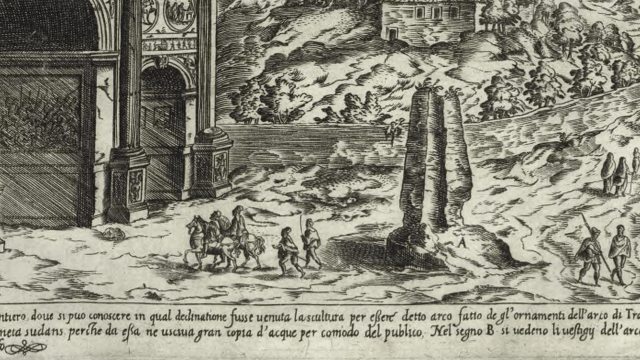At the end of Jahn’s 1851 edition of the works of Juvenal, the editor helpfully gathered together various accounts of the life of Juvenal which are found in the medieval manuscripts that transmit to us the text of Juvenal’s Satires. The value of all of these biographies is very doubtful, but it is interesting to see them. An old Geocities website, existing now here, includes most of them and some other material, which spurred me to look at one of them.
Here’s Jahn’s Vita number III:
Iuvenalis iste Aquinatis fuit, id est ex Aquinio oppido, temporibus Neronis Claudii imperatoris. Prima aetate siluit, ad mediam fere aetatem declamavit, unde et quasi diu tacuit. Fecit quosdam versus in Paridem pantomimum, qui tunc temporis apud imperatorem plurimum poterat. Hac de causa venit in suspicionem, quasi istius imperatoris tempora notasset. Sic obtentu militiae pulsus urbe tandem Romam cum veniret et Martialem suum non videret, ita tristitia et angore periit anno aetatis suae altero et octuagesimo.
— O. Jahn, D. Iunii Iuvenalis Saturarum Libri V, 1851, p.388.
Translating this, I get something like this.
That Juvenal was an Aquinatan, i.e. from the town of Aquinium, in the time of the emperor Nero Claudius. In his early years he was quiet, until almost middle age he declaimed, from when again he was silent as if for a long time. He made some verses against Paris, a pantomime actor, who at that time had very great influence with the emperor. For this reason he came under suspicion, as if he had
documentedsatirised[1] the time of that Emperor. So having been expelled from the city under the pretext of military service, when at last he came to Rome and did not see his friend Martial, then he perished from sadness and anguish, at the age of eighty-one.
I thought that I would share a few items that struck me as I looked at this.
The town is actually named Aquinum, modern Aquino, rather than Aquinium.
Since Juvenal was a contemporary of Martial, who flourished under Domitian, clearly Juvenal – who calls Domitian a “bald-headed Nero” did not himself live in the days of Nero.
“prima aetate”, from youth, in his early years. There are some interesting remarks in the various dictionaries at Logeion here on the variable meanings of “aetas”.
“quasi diu tacuit”, he fell silent as if for a long time. “quasi diu” misled me, and I resorted to an internet search. I often find that useful information for a translator comes out of this, especially for medieval Latin. Thus I found myself looking at an entry in the Etymologiae of Isidore of Seville, book 5, chapter 25, v. 19:
Depositum est pignus commendatum ad tempus, quasi diu positum.
A ‘deposit’ (depositum) is a security entrusted for a set time, as though it were ‘set down for a long time’ (diu positum).
English translation by Stephen A Barney &c, Cambridge (2006), p.121.
“apud imperatorem plurimum poterat” – had very great influence with the emperor. This nice phrasing came out of Google translate, which can also be a source of a useful word or two; and perhaps more often, is also a source of complete gibberish.
“Romam cum veniret et Martialem suum non videret” – when he came to Rome and did not see his dear (suum) Martial. Both verbs are subjunctive and imperfect, following “cum”, so literally “when he was coming… and was not seeing”. The sense is of an ongoing action – but in English we do better to use “came… and did not see”, which conveys the same sense.
But where does this text come from? Well, Jahn says:
exstat in cod. msc. Is. Vossii v. cl. auctoremque praefert Ael. Donatum, sed uidetur tamen potius ex superiori vita expressa per Cornutum aut Probum aut Asperum aut Euanthium aut similem compilatorem grammaticum.” Henninius.
This footnote is a quote from this “Henninius”, who turns out to be an early and very copious editor (Leyden, 1695). It’s probably quoted from the later Ruperti edition, tho. Uselessly it tells us only that it is found in a miscellaneous manuscript once belonging to Isaac Vossius – I’m not quite sure what he’s saying about Donatus.
But the webpage above adds:
Nach Stephan de Pithoeanis in Iuvenalem scholiis S. 9. A. steht dieselbe vita auch im codex Pithoeanus.
According to Stephan, Concerning the Pithou manuscript of the scholia of Juvenal, p.9, the same vita is present in the Pithou manuscript.
“Stephan” turns out to be an 1881 commentator. But the codex Pithoeanus is Montpellier H25, which is now online. And so indeed it is! It is the second vita on the page at the end, online here. Yes, it’s time for that image again! (I do like it)

This page is, however, a later addition to the 9th century manuscript.
There are all sorts of little bits of Latin around, and it would be nice to see more of them in translation.
- [1]Update: see comment for correction.↩
















